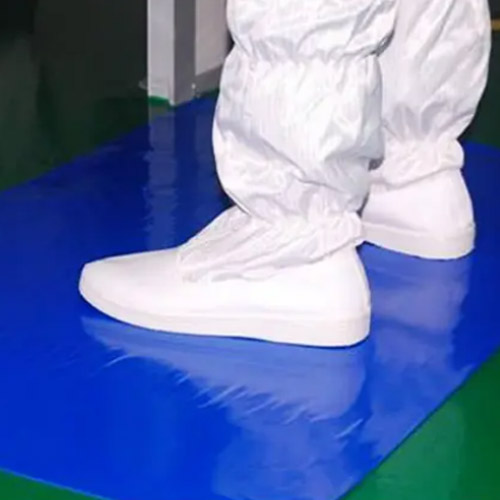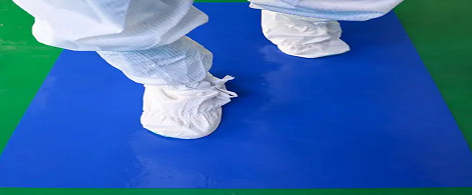When it comes to controlling dirt and dust in environments where cleanliness is important, two common mat options come to mind: Sticky Mats and Regular Mats. Both types are designed to trap dirt and debris, but they function in different ways and are suitable for different applications.

What Are Sticky Mats?
Sticky mats, often referred to as tacky mats, are specialized mats designed to remove dirt, dust, and debris from shoes, wheels, or equipment as they enter a clean or controlled area. These mats are typically made of several layers of adhesive sheets that trap particles as people walk across them. Once a layer becomes dirty, it can be peeled off to reveal a clean surface underneath.
Key Features of Sticky Mats
- Made of adhesive layers: Sticky mats are composed of multiple adhesive layers, which can be peeled off once they become covered in dirt and dust.
- Disposable and replaceable: As each sticky layer becomes saturated with dust and dirt, it can be easily peeled off and discarded, making sticky mats a convenient and low-maintenance option.
- Widely used in sensitive environments: Sticky mats are used in cleanrooms, hospitals, laboratories, manufacturing facilities, and other areas where maintaining a dust-free environment is crucial.
Benefits of Sticky Mats
- High particle capture efficiency: Sticky mats excel at capturing even the smallest dust and dirt particles.
- Minimal maintenance: After the adhesive surface becomes covered with dirt, you simply peel it off and replace it, eliminating the need for regular washing or vacuuming.
- Highly effective for clean environments: Sticky mats are perfect for environments where contamination could lead to safety or quality issues, such as semiconductor manufacturing or medical research.
What Are Regular Mats?
Regular mats, in contrast, are typically made from durable materials such as rubber, carpet, or woven fibers. They are designed to trap dirt and dust by capturing particles in their fibers as people walk across them. While they are less specialized than sticky mats, regular mats are still an effective way to control dirt in high-traffic areas.
Key Features of Regular Mats
- Made of durable materials: Regular mats are generally constructed from materials such as rubber, carpet, vinyl, or coir, designed to withstand heavy foot traffic.
- Reusable: Unlike sticky mats, regular mats don’t need to be disposed of after a single use. They can be vacuumed, washed, or hosed down to remove dirt and debris.
- Commonly used in high-traffic areas: Regular mats are often placed in entryways, hallways, offices, and commercial buildings to prevent dirt from being tracked indoors.
Benefits of Regular Mats
- Cost-effective: Regular mats are generally more affordable upfront and can be used repeatedly.
- Suitable for general dirt control: While they are not as effective at trapping fine dust particles, regular mats can still capture larger debris and dirt, making them effective for general use.
- Low-maintenance: Regular mats only require periodic cleaning, such as vacuuming or washing, to keep them functioning.
Sticky Mats vs. Regular Mats: Key Differences
Now that we understand what each type of mat is and their primary uses, let’s look at the key differences between Sticky Mats and Regular Mats. We’ll compare them in terms of dirt and dust capture, effectiveness in different environments, maintenance requirements, cost, and environmental impact.
1. Dirt and Dust Capture Mechanism
- Sticky Mats: Sticky mats are highly effective at trapping dirt, dust, and even microscopic particles. Their adhesive layers remove fine dust particles from shoes, wheels, and equipment before they can enter clean or controlled environments. The sticky surface grabs dust and dirt directly from the soles of shoes, preventing these particles from being spread around.
- Regular Mats: Regular mats trap dirt in their fibers or grooves. While they work well for larger debris like sand and mud, they are less effective at capturing fine dust particles. Their ability to trap dust depends largely on the material and the design of the mat.
2. Effectiveness in Different Environments
- Sticky Mats: Sticky mats are specifically designed for controlled or sensitive environments, such as cleanrooms, laboratories, manufacturing facilities, hospitals, and data centers. These areas require strict cleanliness standards, and sticky mats play a critical role in preventing contamination. They are ideal for environments where even the smallest particle could cause damage or safety concerns.
- Regular Mats: Regular mats are more commonly used in everyday high-traffic areas like entryways, offices, and commercial spaces. They are good for general dirt and debris control in places that don’t require the extreme cleanliness standards of controlled environments. However, they may not be effective in areas that require dust control at a micro level.
3. Maintenance Requirements
- Sticky Mats: One of the main advantages of sticky mats is their minimal maintenance. After the sticky surface becomes covered with dirt and dust, you simply peel off the top layer to reveal a fresh, clean surface. This makes sticky mats extremely convenient and time-efficient. However, sticky mats are disposable, and once all the adhesive layers are used up, the entire mat needs to be replaced.
- Regular Mats: Regular mats, although reusable, require more maintenance. They need to be regularly cleaned by vacuuming, washing, or hosing them down. Over time, as the fibers accumulate dirt, regular mats may lose their effectiveness, and depending on usage, they may need to be replaced after a few years. For larger or heavier debris, these mats often need a more thorough cleaning.
4. Cost Comparison
- Sticky Mats: While sticky mats are highly effective in specialized environments, they tend to be more expensive than regular mats, primarily because they are designed for disposable use. The cost of sticky mats can add up over time if you use them frequently, especially if you need to replace them regularly.
- Regular Mats: Regular mats, on the other hand, are generally much more affordable upfront. They can be reused for a long period with proper maintenance, making them a cost-effective option for general dirt control. However, their long-term effectiveness depends on proper cleaning, and they may eventually need to be replaced.
5. Environmental Impact
- Sticky Mats: Because sticky mats are disposable, they can contribute to environmental waste. After the adhesive layers are used up, the entire mat must be discarded, which may not be ideal for users who are conscious of sustainability. However, some manufacturers offer sticky mats made from biodegradable materials, which helps reduce their environmental impact.
- Regular Mats: Regular mats are more environmentally friendly because they are designed for long-term use and can be cleaned repeatedly. If made from natural fibers or recyclable materials, they can have a lower environmental impact over time compared to sticky mats.
Performance Comparison in Specific Applications
Let’s examine how each type of mat performs in different settings, such as cleanrooms, home entryways, and automotive applications.
1. Cleanroom or Laboratory Settings
- Sticky Mats: In cleanroom environments, where contamination control is critical, sticky mats are essential. They efficiently remove even the smallest dust particles from shoes or equipment before they can enter sensitive areas. Their ability to capture fine particles ensures that the air and surfaces remain clean, reducing the risk of contamination and maintaining safety standards.
- Regular Mats: Regular mats are not effective in cleanroom environments because they cannot trap microscopic particles effectively. Their fibers may catch larger debris, but fine dust will pass through, making them unsuitable for highly controlled areas.
2. Home or Office Entryways
- Sticky Mats: While sticky mats are useful for controlled environments, they are less commonly used in homes or offices. Their disposable nature and the need to replace layers frequently can be inconvenient for casual use. Sticky mats might be used in areas where extreme cleanliness is required, such as medical labs or sterile environments.
- Regular Mats: Regular mats are ideal for home entryways and office spaces. They are effective at trapping dirt, mud, and water from shoes, preventing debris from being tracked into the building. Regular mats can be easily cleaned, and they are available in a variety of sizes, designs, and materials to fit different needs.
3. Automotive Applications
- Sticky Mats: Sticky mats can also be beneficial in automotive applications, especially in car dealerships, repair shops, or automotive factories. They can remove dirt from tires, tools, or equipment before entering vehicles, keeping the interior clean and free from dirt.
- Regular Mats: Rubber mats are commonly used in vehicles to protect the interior from dirt, mud, and moisture. These mats can trap larger debris and are easy to clean, but they may not be as effective in preventing fine dust particles from entering the car compared to sticky mats.
Which Is More Effective for Dirt and Dust Control?
Both Sticky Mats and Regular Mats serve important roles in dirt and dust control, but their effectiveness depends on the environment in which they are used.
- Sticky Mats are ideal for environments where cleanliness is critical and where even the smallest particles can cause significant issues. They are highly effective at capturing fine dust particles, making them perfect for cleanrooms, laboratories, and manufacturing facilities. However, they come at a higher cost due to their disposable nature.
- Regular Mats are best suited
for everyday use in high-traffic areas like entryways, offices, and commercial buildings. They can trap larger debris and prevent dirt from spreading, but they are not as effective in environments that require strict contamination control. Regular mats are reusable and cost-effective, making them a practical choice for general dirt control.

